Only in a Fairy
Tale:
Discerning the Form
through the Art of Illustration
Part 3
Flatness
of Fairy Tales
In the minds of many today, fairy tales are
usually dictated by the Disney versions, the color palette and specific idea of
whom each of the character are.
For many, Cinderella is not just any girl, it is Disney’s girl, and the
same goes for many of the other fairy tales colonized by Disney. However, in
A.S. Byatt’s introduction to Maria Tatar’s annotated Grimm, she states that the
original tales have a “discrete, salutary flatness” and that they are “older,
simpler and deeper than the individual imagination.” I started to realize that
these tales are truly flat, but not in a negative sense. They are flat in that they are
universal, timeless, and they are able to connect to any individual, regardless
of who they are. They do not need
to be specific and elaborate, they instead have the ability to reach out and
touch the human soul and illuminate truth in a way that lights up the
imagination and creates this magical space where the reader or listener is
hooked and floods the page with the colors of their own imagination.
Byatt also
cites Max Luthi’s description of fairy tales: “an abstract world, full of discrete,
interchangeable people, objects, and incidents, all of which are isolated and
are nevertheless interconnected, in a kind of web…” Thus from one tale to the next, princesses and princes,
wicked step-mothers and kings, fill the role of their archetypes, but are not
unique individuals, and could easily be transplanted between tales. Moreover,
the aesthetic of the tales, the colors and imagery, has a certain palette,
Luthi says: “red, white, black and the metallic colors of gold and silver and
steel.” This bareness even in
terms of color is then typified and exalted by the illustrations of Lisbeth
Zwerger. Here in a faultless
flatness she exudes the tension, annoyance, fear, movement, and pulse that
fills The Frog Prince. Zwerger is
able to wedge her illustrations into the flatness of the fairy tale, her
princess could be any girl, what is unique are the emotions she elicits, even
in its bareness and simplicity, and the magical space that she creates between word,
book, image and reader.
Also, check out Donna's wonderful review of a new Lisbeth Zwerger collection over at "32 Pages"! : http://32pages.ca/2012/11/14/lisbeth-zwerger-and-the-brothers-grimm/
